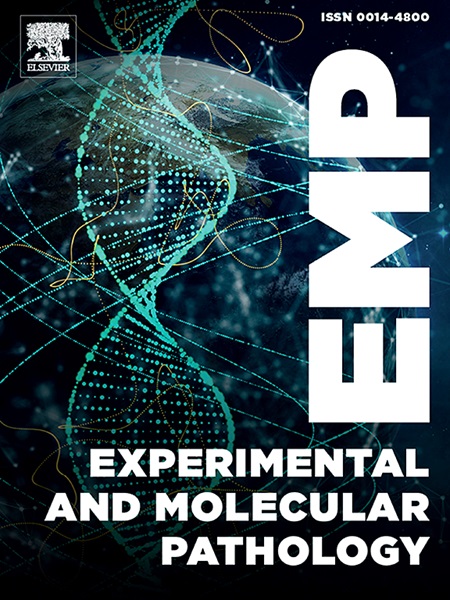Hyperinsulinemic male LEW.1WR1 rats show early signs of impaired liver metabolism
IF 3.7
4区 医学
Q2 PATHOLOGY
引用次数: 0
Abstract
Weanling LEW.1WR1 (1WR1) rats are susceptible to type 1 diabetes (T1D) and hyperinsulinemic. Similar to human patients with T1D, these animals are susceptible to developing fatty liver infiltrates. Insulin resistance-related steatosis can lead to the development of severe forms of nonalcoholic fatty liver disease (NAFLD). Previous work in 1WR1 rats suggests that in the absence of T1D, they have increased body mass that is not reconciled by measuring their abdominal fat pads; this suggests 1WR1 rats have an underlying predisposition to store fat in the liver unrelated to diabetes status. We hypothesized that 1WR1 rats show early signs of NAFLD development. We assessed proteomics changes in the livers of glucose intolerant and hyperinsulinemic young adult 1WR1 rats to identify early detectable characteristics of NAFLD development.
Our results show young adult 1WR1 rats have UBD/FAT10 gene over expression in the liver. Additionally, they have decreased mitochondrial protein levels, which may lead to lipid accumulation in the liver. A quantitative proteomic analysis showed protein expression related to branch chain fatty acid metabolism, fatty acid beta-oxidation, and oxidative phosphorylation in the liver is significantly different in 1WR1 rats compared to control LEW/SsNHsd (SsNHsd) rats. In summary, our study shows that 1WR1 rats developed early characteristics of mitochondrial dysfunction and insulin resistance in the liver independent of T1D, which are commonly observed with NAFLD development.

高胰岛素血症的雄性LEW.1WR1大鼠表现出肝脏代谢受损的早期迹象
断奶期LEW.1WR1 (1WR1)大鼠易患1型糖尿病(T1D)和高胰岛素血症。与人类T1D患者相似,这些动物容易发生脂肪肝浸润。胰岛素抵抗相关的脂肪变性可导致严重形式的非酒精性脂肪性肝病(NAFLD)的发展。先前对1WR1大鼠的研究表明,在缺乏T1D的情况下,它们的体重增加了,这与测量腹部脂肪垫的结果不一致;这表明1WR1大鼠在肝脏中储存脂肪的潜在倾向与糖尿病状态无关。我们假设1WR1大鼠表现出NAFLD发展的早期迹象。我们评估了葡萄糖不耐受和高胰岛素血症的年轻成年1WR1大鼠肝脏中的蛋白质组学变化,以确定NAFLD发展的早期可检测特征。我们的研究结果显示,年轻成年1WR1大鼠肝脏中存在UBD/FAT10基因过表达。此外,它们降低了线粒体蛋白水平,这可能导致肝脏中的脂质积累。定量蛋白质组学分析显示,与对照组LEW/SsNHsd (SsNHsd)大鼠相比,1WR1大鼠肝脏中分支链脂肪酸代谢、脂肪酸β -氧化和氧化磷酸化相关的蛋白质表达显著不同。综上所述,我们的研究表明,1WR1大鼠出现了独立于T1D的肝脏线粒体功能障碍和胰岛素抵抗的早期特征,这些特征在NAFLD的发展中很常见。
本文章由计算机程序翻译,如有差异,请以英文原文为准。
求助全文
约1分钟内获得全文
求助全文
来源期刊
CiteScore
8.90
自引率
0.00%
发文量
78
审稿时长
11.5 weeks
期刊介绍:
Under new editorial leadership, Experimental and Molecular Pathology presents original articles on disease processes in relation to structural and biochemical alterations in mammalian tissues and fluids and on the application of newer techniques of molecular biology to problems of pathology in humans and other animals. The journal also publishes selected interpretive synthesis reviews by bench level investigators working at the "cutting edge" of contemporary research in pathology. In addition, special thematic issues present original research reports that unravel some of Nature''s most jealously guarded secrets on the pathologic basis of disease.
Research Areas include: Stem cells; Neoangiogenesis; Molecular diagnostics; Polymerase chain reaction; In situ hybridization; DNA sequencing; Cell receptors; Carcinogenesis; Pathobiology of neoplasia; Complex infectious diseases; Transplantation; Cytokines; Flow cytomeric analysis; Inflammation; Cellular injury; Immunology and hypersensitivity; Athersclerosis.

 求助内容:
求助内容: 应助结果提醒方式:
应助结果提醒方式:


